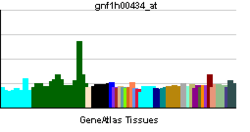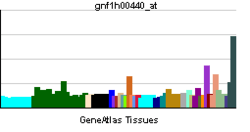SPEF2
| SPEF2 | ||||||
|---|---|---|---|---|---|---|
| Identifiers | ||||||
| Aliases | SPEF2, CT122, KPL2, sperm flagellar 2 | |||||
| External IDs | MGI: 2443727 HomoloGene: 23371 GeneCards: SPEF2 | |||||
| RNA expression pattern | ||||||
  | ||||||
| More reference expression data | ||||||
| Orthologs | ||||||
| Species | Human | Mouse | ||||
| Entrez | ||||||
| Ensembl | ||||||
| UniProt | ||||||
| RefSeq (mRNA) | ||||||
| RefSeq (protein) | ||||||
| Location (UCSC) | Chr 5: 35.62 – 35.81 Mb | Chr 15: 9.58 – 9.75 Mb | ||||
| PubMed search | [1] | [2] | ||||
| Wikidata | ||||||
| View/Edit Human | View/Edit Mouse |
Sperm flagellar protein 2 is a protein that in humans is encoded by the SPEF2 gene.[3][4][5][6]
SPEF2 plays an important role in spermatogenesis and flagellar assembly.[7] SPEF2 is expressed in all ciliated cells and is required for cilia function.[7][8] Sperm contain cilia, and a mutation in the SPEF2 gene can cause male infertility due to immobile sperm.[7][8] In a pig animal model, a SPEF2 mutation affects the sperm tail development.[8] And a loss of function mutation in SPEF2 in mice causes the big giant head phenotype.[7] SPEF2 mRNA and protein products are localized in germ and sertoli cells.[8] Within these cells, SPEF2 is localized in the golgi complex, manchette, basal body and mid piece of the sperm tail.[8] SPEF2 has been shown to interact with the intracellular transport protein IFT20 in the testis.[8]
References
- ↑ "Human PubMed Reference:".
- ↑ "Mouse PubMed Reference:".
- ↑ Nagase T; Kikuno R; Hattori A; Kondo Y; Okumura K; Ohara O (Feb 2001). "Prediction of the coding sequences of unidentified human genes. XIX. The complete sequences of 100 new cDNA clones from brain which code for large proteins in vitro". DNA Res. 7 (6): 347–55. doi:10.1093/dnares/7.6.347. PMID 11214970.
- ↑ Sironen A; Thomsen B; Andersson M; Ahola V; Vilkki J (Mar 2006). "An intronic insertion in KPL2 results in aberrant splicing and causes the immotile short-tail sperm defect in the pig". Proc Natl Acad Sci U S A. 103 (13): 5006–11. doi:10.1073/pnas.0506318103. PMC 1458785
 . PMID 16549801.
. PMID 16549801. - ↑ Sironen A; Vilkki J; Bendixen C; Thomsen B (Sep 2007). "Infertile Finnish Yorkshire boars carry a full-length LINE-1 retrotransposon within the KPL2 gene". Mol Genet Genomics. 278 (4): 385–91. doi:10.1007/s00438-007-0256-7. PMID 17610085.
- ↑ "Entrez Gene: FLJ23577 KPL2 protein".
- 1 2 3 4 Sironen A; Kotaja N; Mulhern H; Wyatt TA; Sisson JH; Pavlik JA; Miiluniemi M; Fleming MD; Lee L (October 2011). "Loss of SPEF2 function in mice results in spermatogenesis defects and primary ciliary dyskinesia". Biol. Reprod. 85 (4): 690–701. doi:10.1095/biolreprod.111.091132. PMC 3184289
 . PMID 21715716.
. PMID 21715716. - 1 2 3 4 5 6 Sironen A; Hansen J; Thomsen B; Andersson M; Vilkki J; Toppari J; Kotaja N (March 2010). "Expression of SPEF2 during mouse spermatogenesis and identification of IFT20 as an interacting protein". Biol. Reprod. 82 (3): 580–90. doi:10.1095/biolreprod.108.074971. PMID 19889948.
Further reading
- Adams MD, Kerlavage AR, Fleischmann RD, et al. (1995). "Initial assessment of human gene diversity and expression patterns based upon 83 million nucleotides of cDNA sequence" (PDF). Nature. 377 (6547 Suppl): 3–174. PMID 7566098.
- Maruyama K; Sugano S (1994). "Oligo-capping: a simple method to replace the cap structure of eukaryotic mRNAs with oligoribonucleotides". Gene. 138 (1–2): 171–4. doi:10.1016/0378-1119(94)90802-8. PMID 8125298.
- Suzuki Y, Yoshitomo-Nakagawa K, Maruyama K, et al. (1997). "Construction and characterization of a full length-enriched and a 5'-end-enriched cDNA library". Gene. 200 (1–2): 149–56. doi:10.1016/S0378-1119(97)00411-3. PMID 9373149.
- Strausberg RL, Feingold EA, Grouse LH, et al. (2003). "Generation and initial analysis of more than 15,000 full-length human and mouse cDNA sequences". Proc. Natl. Acad. Sci. U.S.A. 99 (26): 16899–903. doi:10.1073/pnas.242603899. PMC 139241
 . PMID 12477932.
. PMID 12477932. - Ota T, Suzuki Y, Nishikawa T, et al. (2004). "Complete sequencing and characterization of 21,243 full-length human cDNAs". Nat. Genet. 36 (1): 40–5. doi:10.1038/ng1285. PMID 14702039.
- Kimura K, Wakamatsu A, Suzuki Y, et al. (2006). "Diversification of transcriptional modulation: Large-scale identification and characterization of putative alternative promoters of human genes". Genome Res. 16 (1): 55–65. doi:10.1101/gr.4039406. PMC 1356129
 . PMID 16344560.
. PMID 16344560.